Key takeaways:
- Remote learning fosters self-discipline, time management, and independent problem-solving skills.
- Emotional challenges, such as loneliness, can lead to deeper personal reflection and understanding of one’s beliefs.
- Engaging strategies like multimedia resources and personal connections enhance participation and create a sense of community despite physical distance.
- Adaptability and vulnerability are crucial in overcoming challenges and fostering a supportive remote learning environment.
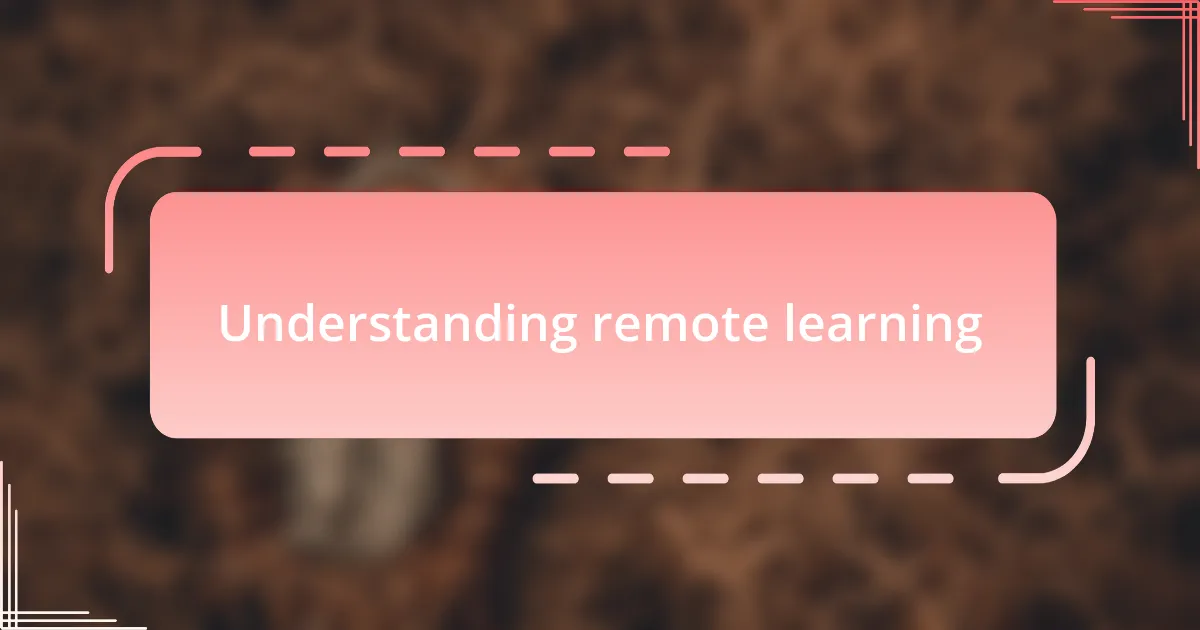
Understanding remote learning
Remote learning fundamentally changes how we engage with education. I remember my first online class feeling like an adventure, yet it was laden with uncertainty. Was this new format going to be as effective as sitting in a classroom? I quickly learned that, while it lacks the physical presence, the flexibility of remote learning can foster a more personalized educational experience.
In my experience, remote learning isn’t just about accessing lectures online; it’s about developing self-discipline and time management skills I never knew I needed. There were mornings I struggled to stay motivated, especially when my bed seemed so inviting. Would I have learned different lessons if I was physically present with peers? I think it enriched my ability to connect concepts on my own terms, diving deeper into subjects that sparked my curiosity.
The emotional journey of remote learning is often overlooked. I recall the loneliness of staring at a screen, missing the vibrant discussions we might have had in person. However, this solitude also gifted me space to reflect on my beliefs and values more profoundly, especially in a context like Religious Education. Have you ever felt that a change in environment led to a newfound understanding of your learning? For me, this was certainly the case.
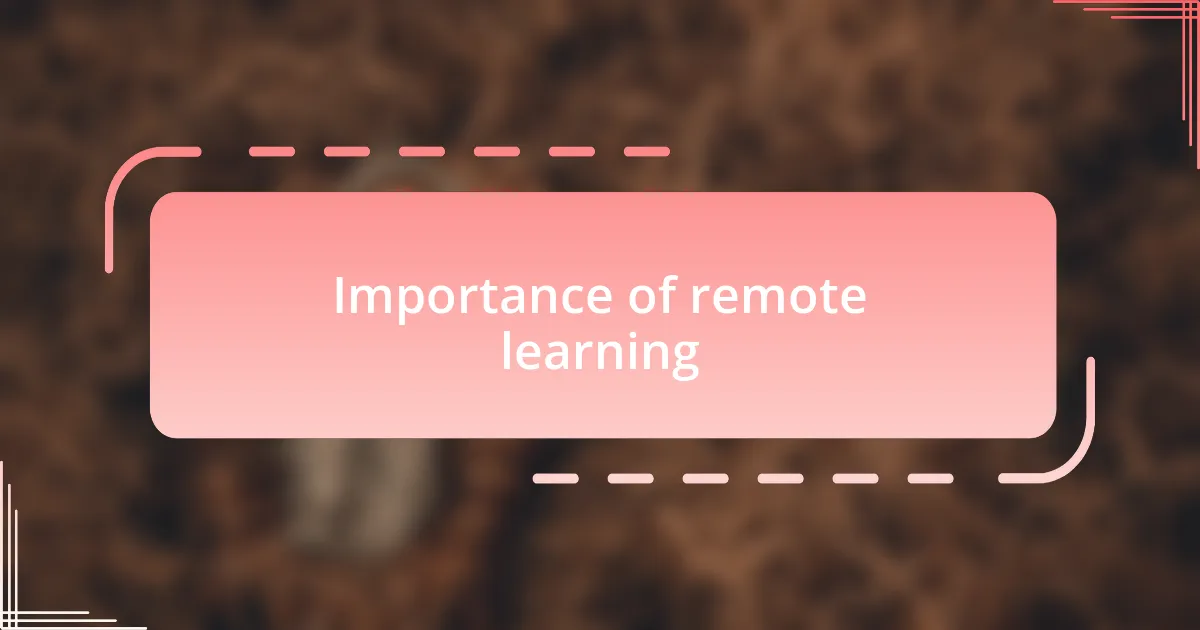
Importance of remote learning
The importance of remote learning extends beyond convenience; it cultivates resilience. I distinctly remember a project for my Religious Education class that required me to research different faith practices from home. At first, I felt overwhelmed, but as I navigated through online resources, I discovered a sense of independence. I realized that these challenges built my ability to adapt and problem-solve—skills that are invaluable in both academic and real-world contexts.
Additionally, the accessibility of remote learning cannot be overstated. I encountered various online forums where students from all over the world shared their insights and experiences. This diversity of thought opened my eyes to perspectives I would have never encountered in a traditional classroom. Have you ever found wisdom in a viewpoint that challenged your own? That’s exactly what happened to me, broadening my understanding of global religious practices in ways I hadn’t anticipated.
Moreover, remote learning encourages a unique form of community building. Throughout my journey, I participated in virtual study groups that turned out to be surprisingly engaging. There was something special about collaborating from the comfort of our homes—sharing thoughts, debating interpretations, and supporting one another in a more intimate setting. This made me ponder, how does physical distance redefine our connections? For me, it created bonds that felt genuine and nurturing, contributing to my overall learning experience in profound ways.
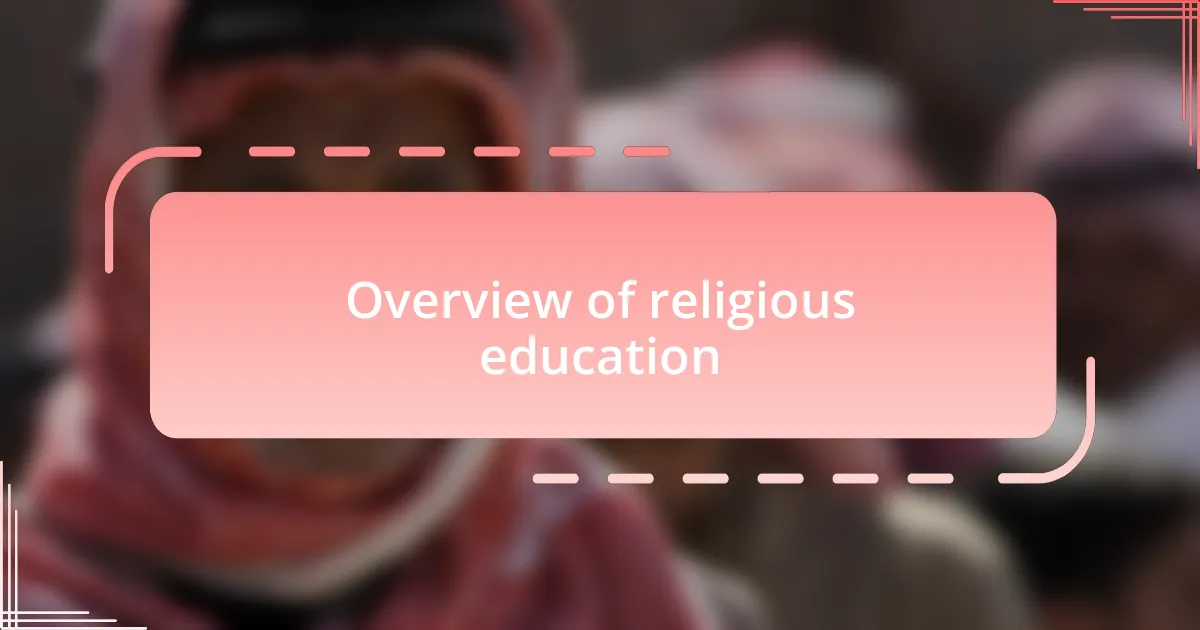
Overview of religious education
Religious education plays a crucial role in shaping individuals’ understanding of moral values and cultural perspectives. I remember my first encounter with the teachings of various religions; it felt like stepping into a vibrant tapestry of beliefs and traditions. This exposure not only expanded my knowledge but also cultivated empathy as I began to appreciate the core tenets that unite humanity, even amid diverse practices.
In my experience, the beauty of religious education lies in its ability to provoke deep conversations and reflections. During one class discussion, a fellow student shared their personal experience with faith, which sparked a lively debate about purpose and identity. I was struck by the realization that, through these dialogues, we were not just learning about religions but also exploring our own beliefs and values. Have you ever found a connection in unexpected places? For me, that moment emphasized that understanding spirituality is as much about listening as it is about sharing.
Furthermore, the interdisciplinary nature of religious education enriches our worldview. I vividly recall a project that combined religious texts with historical events, allowing me to see how faith and society influence one another. By analyzing these intersections, I became more aware of the role religion plays in shaping cultures and individual lives. It begs the question: can we fully understand a culture without understanding its spiritual foundations? Diving into this relationship opened my eyes to the ever-present impact of religious thought in contemporary issues.
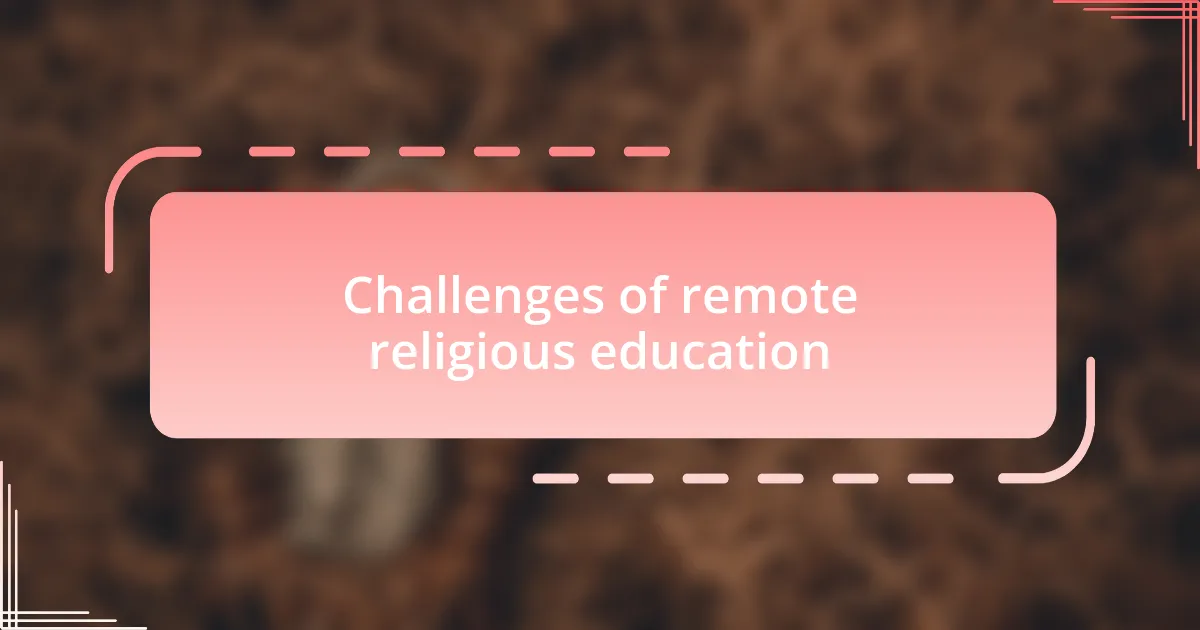
Challenges of remote religious education
Remote religious education presents unique challenges that often test both students and educators. One significant issue I’ve faced is the difficulty in fostering a sense of community. In traditional settings, we could share experiences and build connections organically. During remote classes, I often wonder how we can replicate that intimate atmosphere when all we see are faces on a screen.
Technical issues also pose a considerable hurdle. I recall a particularly frustrating session where my internet dropped just as we were about to discuss an important text. That moment heightened my awareness of how technology can both connect and separate us. Have you ever been disconnected right when a conversation was about to deepen? It’s in those moments that I truly appreciated the value of an engaged and supportive learning environment.
Lastly, the challenge of maintaining student engagement is real. Online learning can feel monotonous, and I find myself asking my peers difficult questions to stir up discussions. Sometimes, I feel like I’m missing the nuanced expressions and body language that enrich our conversations. How can we keep the spark alive remotely? I believe it requires creativity and a willingness to explore new methods, perhaps incorporating multimedia resources or small group discussions to awaken interest and focus.
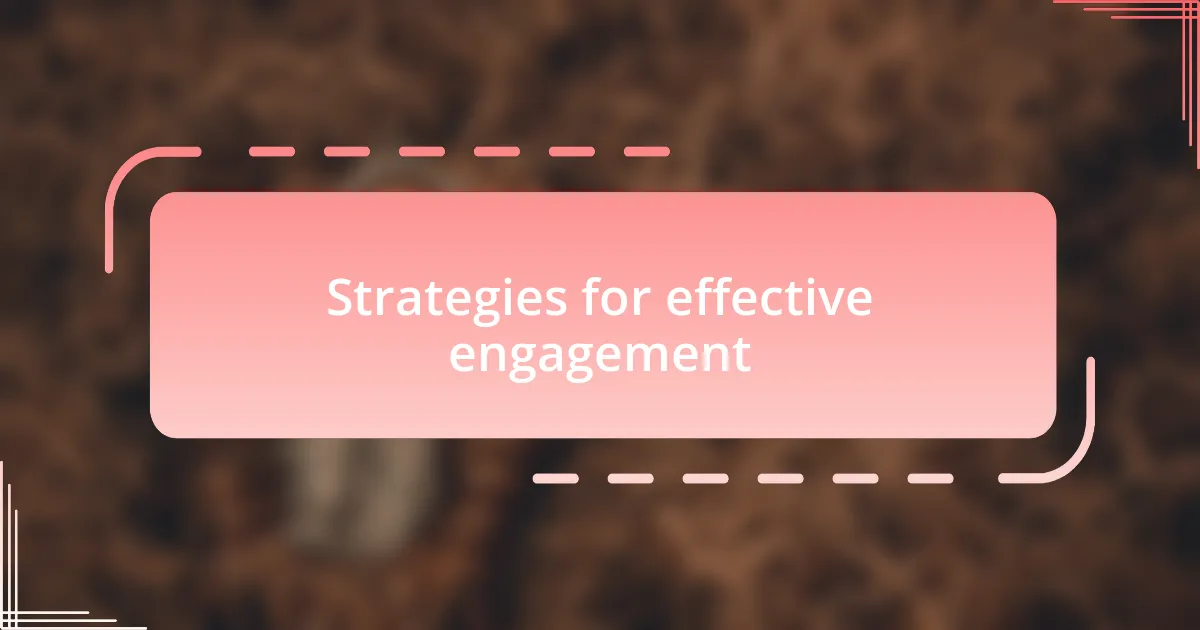
Strategies for effective engagement
To truly engage remote learners, I’ve found that incorporating interactive elements makes a significant difference. For instance, I once organized a virtual breakout session where participants could discuss their perspectives on a parable in small groups. This not only fostered participation but ignited enthusiasm, as I could see their faces light up with excitement when they connected the text to their own lives. Engaging students through collaboration can create those vital connections that are often missing in online settings.
Another strategy that has worked wonders for me is utilizing multimedia resources. I vividly remember sharing a short video that illustrated a key religious concept during one lesson. The change in energy was palpable. Students responded with greater interest and were more inclined to share their thoughts afterward. Visual aids can bridge that gap, making the environment more stimulating and relatable. When was the last time you felt inspired by a video or image?
Above all, personal connection is paramount in remote education. I make it a practice to check in with my classmates individually, perhaps via a quick message or during casual chats. During one such exchange, a peer opened up about how they felt isolated, and this led to a small group forming to study together. It reminded me that even in a virtual realm, showing authentic care can forge those necessary bonds, reminding us that we are all in this journey together.
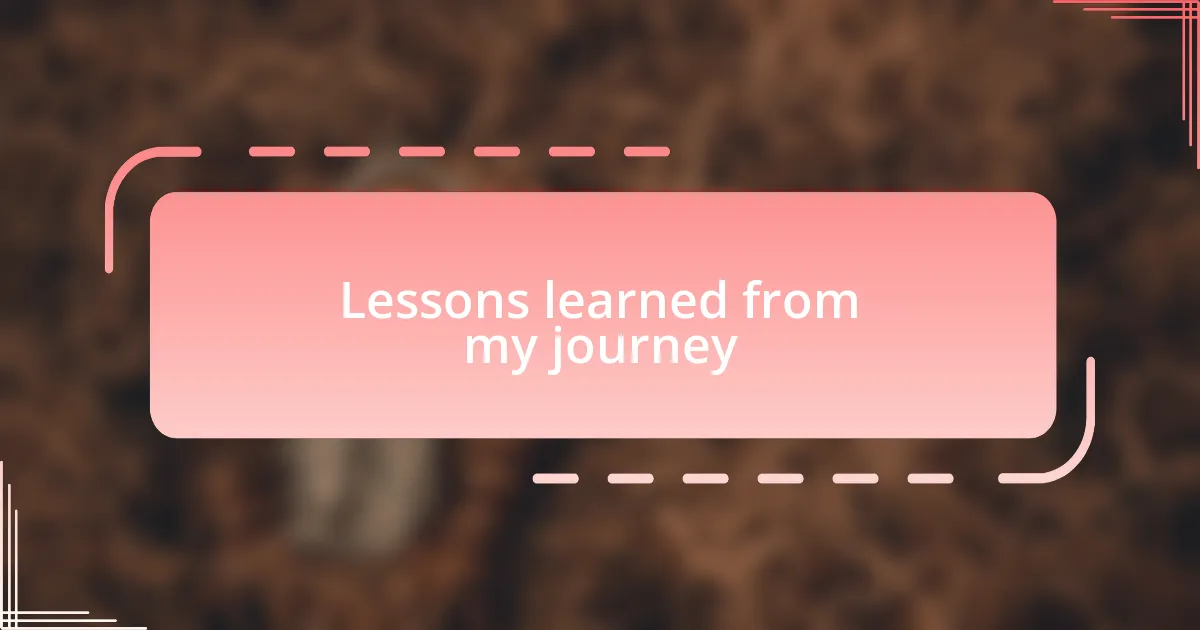
Lessons learned from my journey
One significant lesson I learned on my journey is the importance of adaptability. I recall a particularly challenging session when the technology failed, and rather than succumbing to frustration, I quickly shifted to a more discussion-based approach. This experience taught me that flexibility can turn obstacles into opportunities for deeper engagement and connection with students.
Another important insight has been the value of vulnerability in the remote learning environment. I once shared my personal struggles with staying focused and motivated while learning online. This openness invited others to share their own challenges, creating a sense of solidarity and understanding among us. It made me realize that embracing our imperfections can enrich the learning journey, as it fosters a space where everyone feels comfortable to express themselves.
Finally, I discovered that reflection is a powerful tool for growth. After each lesson, I took the time to assess what worked and what didn’t. This practice not only helped me improve my teaching methods but also reminded me of the ongoing nature of our learning journeys – both for myself and my peers. Have you ever considered how reflection might enhance your own experiences? I’ve found that embracing this habit can be transformative, allowing for continuous development in our educational paths.